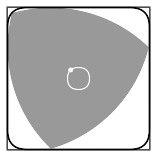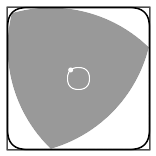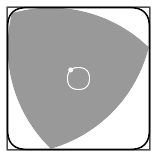I've been paid to do it plenty of times. Not for a shaft but as a slot with square ends and flat bottom. It's just cut with an end mill then cut corners with smallest end mill practical for the size slot then broach or file. But sometimes you can leave the corners with a very small radius and still be within tolerances.
-
Welcome back Guest! Did you know you can mentor other members here at H-M? If not, please check out our Relaunch of Hobby Machinist Mentoring Program!
You are using an out of date browser. It may not display this or other websites correctly.
You should upgrade or use an alternative browser.
You should upgrade or use an alternative browser.
How Are Slotted Keyways Squared Off?
- Thread starter Riaan
- Start date
- Joined
- Aug 22, 2012
- Messages
- 4,264
- Joined
- Dec 8, 2013
- Messages
- 2,651
Or by pushing and then scraping up at the end. You'd have to consider chip clearance when grinding the tool, of course, but I don't see why a machine could not do what I did by hand the other day: an entire (small) keyway with chisels.Could a shaper surmount the problem of swarf by scraping down and "pulling" towards the open end of the slot?
- Joined
- Jul 21, 2015
- Messages
- 566
I think the guy was trying to get away from the radi at the end of the key way . The end mill would answer his problem.
- Joined
- Feb 7, 2011
- Messages
- 5,039
If this is a key seat Then the more square the corners the weaker the part. The ramped end from a key seat cutter is much stronger than one cut with an end mill also the bottom of the sides should have a radius also. Any square corner is a potential cracking point.
- Joined
- Jul 26, 2011
- Messages
- 4,142
I'd just mill the slot with an end mill,and square up the end with a cape chisel. A cape chisel cuts a narrow slot. You can still find them these days,but in limited widths only,like 1/8" and 1/4". Old time machinists used them to cut keyways into shafts that were very difficult to remove,like shafts in complicated overhead line shafts,or on locomotives. It was not uncommon in those days for a decent machinist to be able to cut a keyway.
They also chipped away the crusty outer layer on rough cast lathe beds using had chisels(cold chisels). A good man was expected to chisel 6 feet of a Vee way in a day. Then,with the crust gone,more accurate scraping and filing of the lathe bed could begin. Must have been a truly hard,exhausting,miserable task. Something your body had to get used to. But,so many jobs were like that in the old days. Like sailors "Fisting canvas",curling up a huge sail in a storm,often when the canvas was frozen. And,standing on a "Footrope" high above the deck. One slip and you were either killed crashing to the deck,or overboard in a rough sea,never to be seen again.
This was in the early days of machining,when large planers and milling machines were few and far between. Today we do everything with machinery. Even hand scraping is becoming a thing of the past,except in re conditioning of machines by skilled operators.
They also chipped away the crusty outer layer on rough cast lathe beds using had chisels(cold chisels). A good man was expected to chisel 6 feet of a Vee way in a day. Then,with the crust gone,more accurate scraping and filing of the lathe bed could begin. Must have been a truly hard,exhausting,miserable task. Something your body had to get used to. But,so many jobs were like that in the old days. Like sailors "Fisting canvas",curling up a huge sail in a storm,often when the canvas was frozen. And,standing on a "Footrope" high above the deck. One slip and you were either killed crashing to the deck,or overboard in a rough sea,never to be seen again.
This was in the early days of machining,when large planers and milling machines were few and far between. Today we do everything with machinery. Even hand scraping is becoming a thing of the past,except in re conditioning of machines by skilled operators.
- Joined
- Dec 8, 2013
- Messages
- 2,651
I have several of those. Here is a picture of some (not mine): http://www.iforgeiron.com/topic/26151-what-are-these-chisels-used-for/A cape chisel cuts a narrow slot. You can still find them these days,but in limited widths only,like 1/8" and 1/4".
Hi Riaan,An example of what I'm on about. How would one get rid of the sloping metal so that the slot is perfectly cuboid?
I've been tryin to suss this problem and have no idea.
Personally I would shape a metal to fit the curve on the end on the groove, as long as it need be and silver solder or weld it into place, then mill off the top to have it match the top of the shaft.
Last edited by a moderator:
- Joined
- Aug 19, 2013
- Messages
- 764
Gentlemen,
I've always wondered about this. Assuming you have milled a slot in a piece of stock:
1) Using an end mill cutter, the inner end of the slot will be round when viewed from the top.
2) Using a milling cutter, the inner end of the slot will have a ramp when viewed from the side.
(I hope my terminology is acceptable!)
How would one go about achieving perfectly squared inner corners? Also, is there some sort of machine that does the job first time?
Thanks!
Riaan
While not likely a hobby machine it can be don by EDM (Electric discharge machine)



